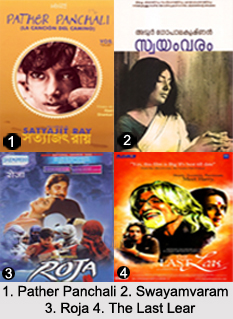 One of the earliest examples of Parallel Cinema dates back to the 1920s, Baburao Painter"s 1925 silent film "Savkari Pash" (Indian Shylock), acclaimed a realistic breakthrough about a poor peasant, portrayed by V. Shantaram, who loses his land to a greedy moneylender and is forced to migrate to the city to become a mill worker. One of its shots of a howling dog near a hut was considered a milestone at the time in the march of Indian Cinema. V. Shantaram"s film "Duniya Na Mane" (1937) is another early realistic example that daringly critiqued the treatment of women in Indian society.
One of the earliest examples of Parallel Cinema dates back to the 1920s, Baburao Painter"s 1925 silent film "Savkari Pash" (Indian Shylock), acclaimed a realistic breakthrough about a poor peasant, portrayed by V. Shantaram, who loses his land to a greedy moneylender and is forced to migrate to the city to become a mill worker. One of its shots of a howling dog near a hut was considered a milestone at the time in the march of Indian Cinema. V. Shantaram"s film "Duniya Na Mane" (1937) is another early realistic example that daringly critiqued the treatment of women in Indian society.
Parallel Cinema movement began to take shape in late 1940s and 1950s, with films like Chetan Anand"s "Neecha Nagar" and Satyajit Ray"s internationally recognised trilogy "Pather Panchali", "Aparajito" and "Apur Sansar". Art films which have also garnered commercial success at the movies include Bimal Roy"s "Do Bigha Zamin" (1953) and Guru Dutt"s "Pyaasa" (1957). Other early examples of such films in Bengali Cinema, where the movement traces its inception, are Ritwik Ghatak"s "Nagarik" and "Ajantrik" and Mrinal Sen"s "Bhuvan Shome". Surrealism forayed in Kannada Cinema with N. Lakshminarayan`s directorial debut "Naandi" (1964), a critical and commercial success that featured mainstream actors.
Parallel Cinema took a more prominent shape in Hindi films during the 70s and the 80s, with films like "Uski Roti" (1971), "Maya Darpan" (1972), "Ankur" (1974), "Bhumika" (1977), "Ardh Satya" (1983) and "Kasba" (1990). While "Bhumika" was based on the memoirs of a well-known Marathi stage and screen actress of the 40s, Hansa Wadkar, who led a flamboyant and unconventional life, "Ardh Satya" is an acclaimed cop drama that reflects the corruption and mafia-invaded contemporary India, where the protagonist is a cop struggling with both evils around him and his own frailties.
Artistic films started in Malayalam Cinema with pioneer Adoor Gopalakrishnan"s "Swayamvaram" (1972). His other films "Elippathayam" (1981) won the Sutherland Trophy at the London Film Festival and "Mathilukal" (1989) was acclaimed at the Venice Film Festival. Shaji N. Karun"s "Piravi" (1989), "Swaham" (1994) and "Vanaprastham" (1999) were all recognised at Cannes Film Festival. Such films made in Tamil Cinema include "Arangetram", "Mouna Ragam", "Roja", while those in Telugu include "Nimajjanam", "Thiladaanam" and "Vanaja".
Contemporary parallel films of Bollywood include "Dor", "Udaan", "Gangs of Wasseypur", "The Lunchbox" amongst others. Independent films in Indian English are also occasionally produced, such as "15 Park Avenue" (2006), "Being Cyrus" (2006) and "The Last Lear" (2007). The most recent example of an impeccable art film becoming commercially successful is Harpreet Sandhu`s Canadian Punjabi Film "Work Weather Wife" (2014), which marks the beginning of parallel cinema in the Punjabi Film Industry.






